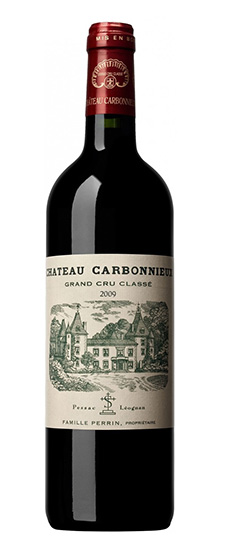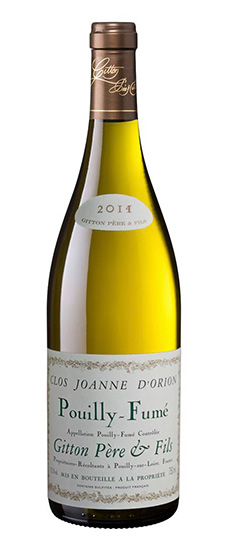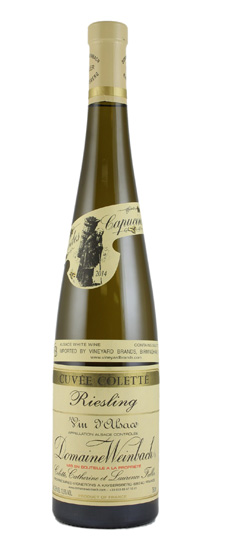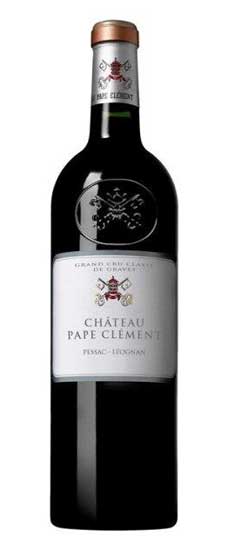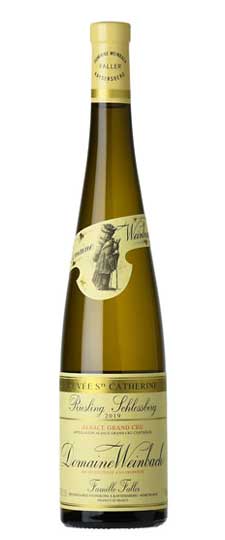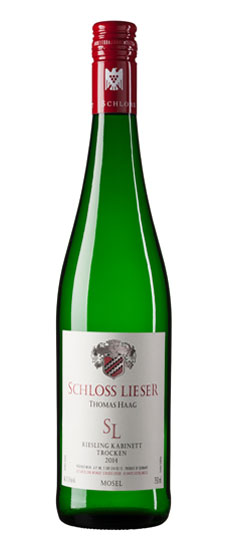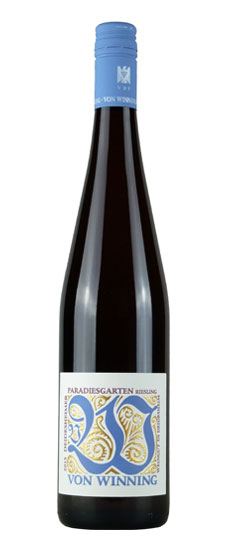Wine Score
96 points James Suckling
The deep apricot nose pulls you into this extravagantly ripe and concentrated dry riesling that’s as precisely balanced as a prima ballerina standing á point. With aeration many delicate, floral nuances emerge. Stunning interplay of fruit and saline minerality. Extremely long, intense finish that’s not a jot tart. From 50-year-old vines at the foot of the Grand Cru Schlossberg. Drink or hold.
Grape Variety
Riesling Wine
Riesling is a light-skinned, aromatic grape of German origin which is – if the majority of top wine critics are to be believed – the world’s finest white wine grape variety.
For many, the claim above may seem at odds with the sea of chaptalized, low-quality wine exported from Germany in the late 20th Century. In truth, very little of that infamous wine was Riesling at all, but instead higher-yielding grapes such as Müller-Thurgau and Silvaner), but the reputation has nonetheless stuck. Riesling has also been stereotyped as just a sweet grape, used only to make sticky wines. But while botrytized Rieslings are among the finest sweet wines in the world, the majority of global Riesling wines are either dry or off-dry.
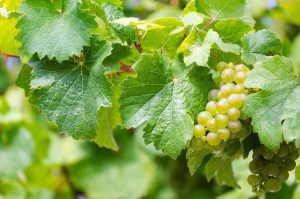 The Riesling vine holds a very different place in the wine world to such great grapes as Cabernet Sauvignon, Merlot or Chardonnay. While these immensely popular varieties have conquered every corner of the winegrowing world, Riesling is conspicuously absent from the core wine regions of France, Spain and Italy. Its fanbase is smaller, but fervent.
The Riesling vine holds a very different place in the wine world to such great grapes as Cabernet Sauvignon, Merlot or Chardonnay. While these immensely popular varieties have conquered every corner of the winegrowing world, Riesling is conspicuously absent from the core wine regions of France, Spain and Italy. Its fanbase is smaller, but fervent.
Riesling’s spiritual home is unquestionably the regions that trace the middle Rhine and the lower Mosel, two of Europe’s great wine rivers. Here we find the key wine regions of Germany, most famously Mosel, Rheinhessen, Rheingau and Pfalz. Riesling vines cover the steep, slate-rich hillsides above these famous rivers, and are used to make crisp, refreshing wines with pronounced acidity.
On the other side of the Rhine lies Alsace, once German but now part of France. Here, Riesling is the most important wine grape variety in terms of both quantity and (arguably) quality. Alsace Riesling has its own individual style, richer and more generous than those made in Germany. This is made possible by the region’s sunny, dry mesoclimate and the shelter provided by the Vosges Mountains.
Austria also produces a large quantity of Riesling, most notably from its eastern Wachau and Kremstal regions. This is made mostly in drier styles, although Lake Neusiedl, just southeast of Vienna, creates a sufficiently humid climate for the production of sweet botrytized Riesling.
Happily, Riesling has found several New World niches to which it is very well suited. The high quality Rieslings now made in Australia’s Clare and Eden valleys have proved this with particular competence. Most notably, Clare Valley Riesling has emerged as a style in its own right, with crisp, citrus-scented acidity and aromas of toast and honeysuckle. Just across the Tasman Sea, New Zealand is also making high-quality Riesling in Canterbury and Otago, while South Africa’s Riesling is also showing promise. The famous ice wines of Canada are made mostly from Riesling or Vidal, and have further demonstrated the cold-resistant characteristics of this hard-wooded variety.
There are various clones and sub-varieties of Riesling in existence, and the variety has multiple variations on its name (e.g. Johannisberg Riesling, Rhine Riesling). To complicate matters, there are several white grape varieties that bear the name Riesling, but are entirely unrelated. The most notable of these are Welschriesling (Riesling Italico), Okanagan Riesling and Cape Riesling, which itself is also known as Crouchen, Paarl Riesling and Clare Riesling.
A rare, pink-skinned variant of Riesling – Roter Riesling – is grown in Germany and Austria. There is ongoing debate as to whether Roter Riesling is a mutated form of traditional Riesling, or vice-versa.
Synonyms include: Weisser Riesling, Johannisberg Riesling, Johannisberger, Rhine Riesling, Riesling Renano.
Food matches for Riesling include:
- Quiche Lorraine; zwiebelkuchen onion cakes (dry)
- Thai green curry (off-dry)
- Key lime pie (sweet)
Region
Alsace Wine
Alsace, in the far north-eastern corner of France, stands out from other French wine regions thanks to its strong Franco-Germanic influences. These are the result of the region having switched back and forth between German and French sovereignty in recent centuries – and are evident not only in Alsatian architecture and culture, but also in the wines.
The Alsace region lies between the Vosges mountains and the French border with Germany, marked by the Rhine river. A long, thin region, it measures 115 miles (185km) north to south and just 25 miles (40km) from east to west. The key viticultural areas here are all located on the lower hillsides of the Vosges, on slopes with east and south-easterly aspects.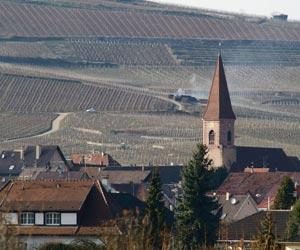 The Vosges play a vital role in defining the region’s terroir; they not only provide protection from the prevailing westerly winds, but also cast a rain shadow over the area, contributing to the low rainfall of its continental climate. They are at their most dense in the southern half of Alsace, where the peaks reach roughly 4600ft (1400m). The glacial activity which created the mountains has also significantly impacted the region’s topography and soils. These vary from sandstone, granite and volcanic rock types in the foothills, to clay-rich limestone and marlstone on the alluvial plains below.
The Vosges play a vital role in defining the region’s terroir; they not only provide protection from the prevailing westerly winds, but also cast a rain shadow over the area, contributing to the low rainfall of its continental climate. They are at their most dense in the southern half of Alsace, where the peaks reach roughly 4600ft (1400m). The glacial activity which created the mountains has also significantly impacted the region’s topography and soils. These vary from sandstone, granite and volcanic rock types in the foothills, to clay-rich limestone and marlstone on the alluvial plains below.
Alsace is the only French wine region to grow significant quantities of Riesling and Gewurztraminer. Both of these varieties are more commonly associated with German wines, and serve as a reminder of Alsace’s history. Pinot Gris, a variety typically marginalized in other French regions as a blending component, is another of the region’s specialties. Sylvaner and Muscat are also traditional Alsace grape varieties, as are Chasselas and Auxerrois although the latter two tend to be used not in single-variety wines but in blends (see Edelzwicker).
Alsace’s wines are produced under three key appellations: Alsace and Alsace Grand Cru for still white wines (both sweet and dry), and Cremant d’Alsace for sparkling. Almost all wine produced in this region fits into one of these three designations.
White varietal wines make up 90% of production here, from the varieties stated above. Key variations in wine styles are marked by their residual sugar levels, which cover the entire sweetness spectrum from bone dry to lusciously sweet. In 1983, the official terms Vendanges Tardives and Selection de Grains Nobles (see French Wine Label Information) were introduced to define and categorize sweet Alsace wines. They remained unique to the region for some time, but are now used in other French appellations such as Jurancon and Coteaux du Layon.
Although significantly outnumbered by white wines, red wines are also made here, mostly from Pinot Noir. Alsace Pinot Noirs are typically lighter-bodied and more rustic than those produced in the variety’s homeland Burgundy, 140 miles (225km) to the south-west. That said, climate change and warmer summers are leading the region’s winemakers to produce noticeably more powerful styles of Pinot Noir.
Dotted along the length of the region are 51 sites marked out as being of particular distinction; the Alsace Grand Cru vineyards.
Producer Notes
About Domaine Weinbach
Domaine Weinbach is a leading wine estate in the Alsace region. It is named after the “wine brook”, a small stream that runs through the main property, which is a former monastery near Kayserberg. The estate is known for its wines made at varying levels of sweetness from Riesling, Pinot Gris, Pinot Blanc, Sylvaner, Gewürztraminer and Muscat.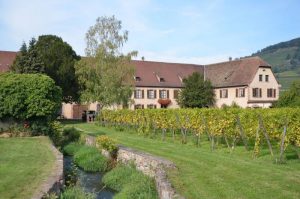 Unusually for the region, Weinbach only uses estate-grown grapes. It has holdings in four nearby Grand Cru vineyards on the slopes of the Weisbach Valley – Schlossberg, Furstentum, Mambourg and Marckgrain. Weinbach also owns the famous 5-hectare (12-acre) monopole, Le Clos des Capucins, which surrounds the cellars just below Schlossberg, and the Altenbourg vineyard adjacent to Furstentum.
Unusually for the region, Weinbach only uses estate-grown grapes. It has holdings in four nearby Grand Cru vineyards on the slopes of the Weisbach Valley – Schlossberg, Furstentum, Mambourg and Marckgrain. Weinbach also owns the famous 5-hectare (12-acre) monopole, Le Clos des Capucins, which surrounds the cellars just below Schlossberg, and the Altenbourg vineyard adjacent to Furstentum.
All of the estate’s 28ha (69 acres) of vineyards have been farmed biodynamically since 2005 and are certified by Ecocert and Demeter. After a gentle, gradual pressing, the juice is slowly fermented in old oak vats using indigenous yeasts.
For several decades the estate was run by Colette Faller and her daughters, winemaker Laurence and sales director Catherine. Laurence died tragically young from a heart attack in 2014, and her mother passed away the following year. Catherine Faller now runs the estate with her sons.

